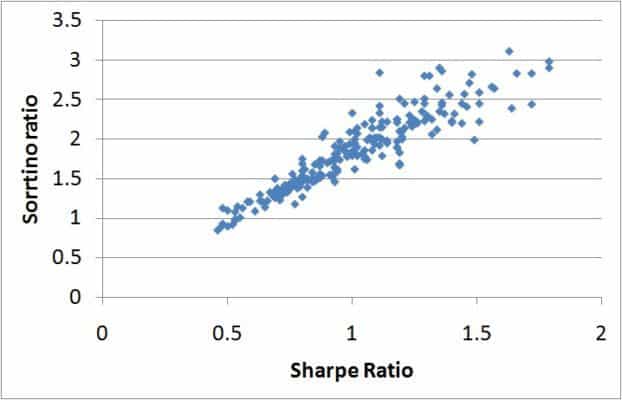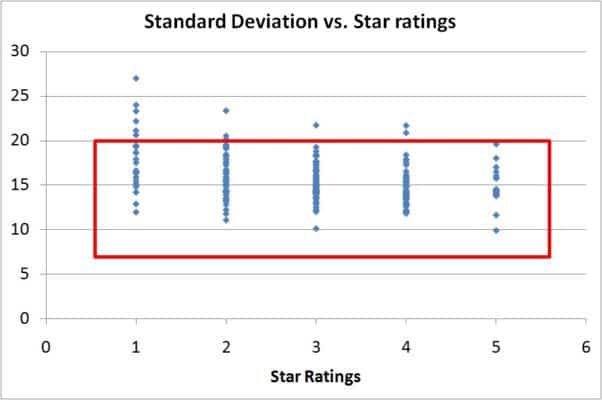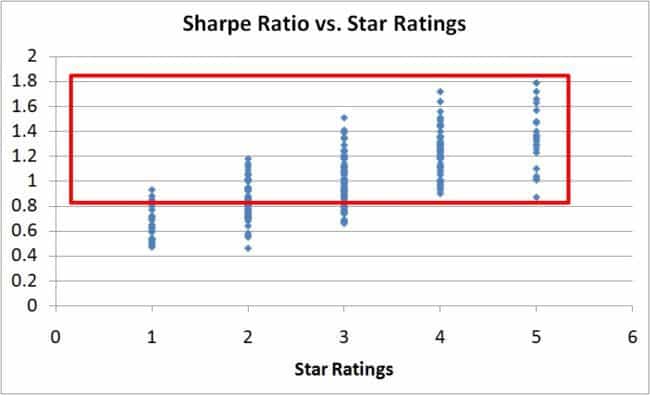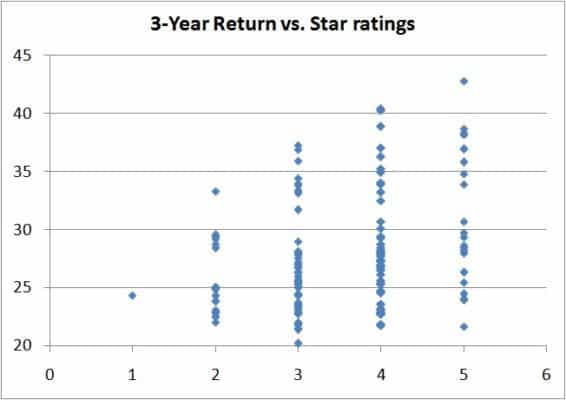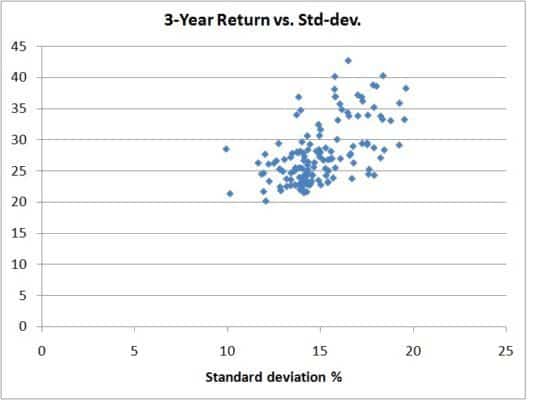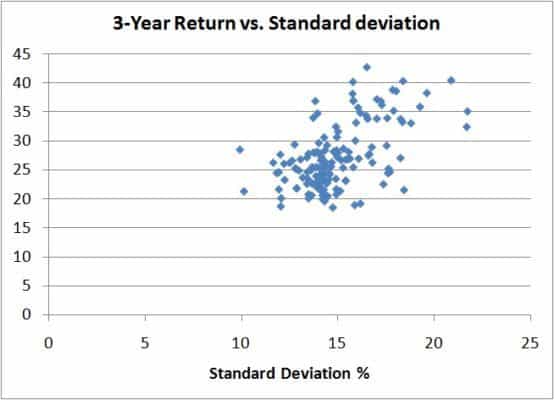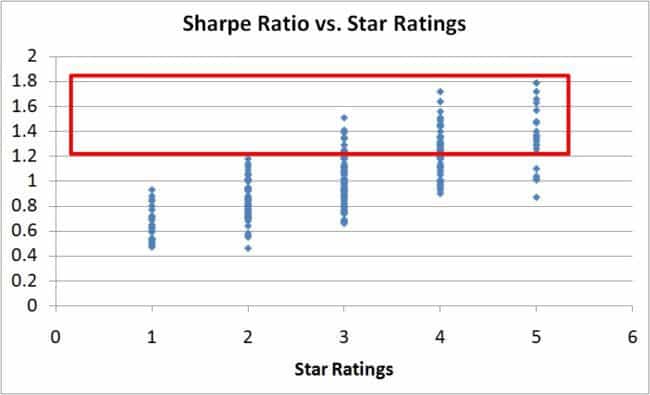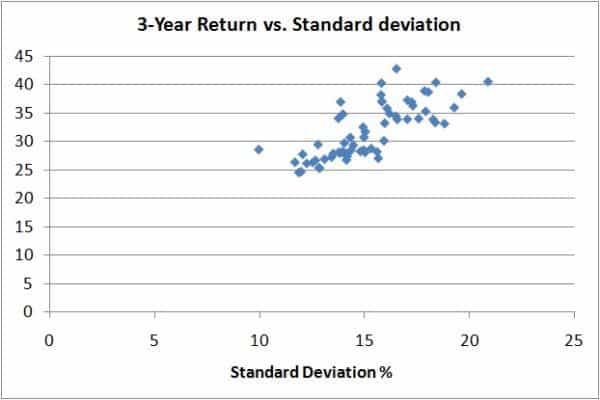Last Updated on December 18, 2021 at 10:41 pm
Mutual fund star ratings are supposed to rate funds on a risk adjusted basis. That is, more the number of stars, better the risk-adjusted performance. If you look at some of the metrics they use to award star ratings, you might agree with me that this is not as easy as it sounds and that the ‘best’ funds need not necessarily carry five stars.
First some simple definitions
1. Beta is a volatility measure and tell us how much the fund changes for a given change in the index. A beta of 1 implies the fund movement is identical to the index movement. A beta of 0.9 implies the fund is 10% less volatile than the index.
Lower the beta, lower the volatility
Join 32,000+ readers and get free money management solutions delivered to your inbox! Subscribe to get posts via email! (Link takes you to our email sign-up form)
🔥Want to create a complete financial plan? Learn goal-based investing? Exclusive access to our DIY tools? Increase your income with your skills? Use this link to enjoy massive discounts on our robo-advisory tool & courses! 🔥
2. Standard deviation is a volatility measure and tell us, for a given set of returns (daily returns in this case), how much do individual returns deviate from the average. This is calculated for both the fund and the benchmark.
Lower the standard deviation, lower the volatility
3. Alpha is a risk adjusted performance measure. It takes into account, the average return of the fund and its benchmark, a risk-free rate defined by the user and how the fund responds to swing in the benchmark (Beta)
Higher the alpha, higher the outperformance of the fund.
4. Sharpe ratio is a risk adjusted performance measure. We calculate the excess returns of the fund wrt a risk-free rate. The ratio is the average of the excess return and the standard deviation of the excess return. This is calculated for both the fund and the benchmark.
Higher the Sharpe ratio, better is the performance (higher returns + low deviation from average return)
5. Sortino Ratio is a risk adjusted performance measure. The Sharpe ratio considers both positive and negative excess returns (wrt risk free rate). The Sortino ratio considers only the negative excess returns while calculating the standard deviation. There should be enough negative excess return data points to justify the use of the Sortino ratio. To take care of this, daily returns are used (instead of monthly returns as done by AMCs/fund portals).
Higher the Sortino ratio, better is the performance (higher returns + low negative deviation from average return)
The next step is to understand that these metrics are not independent
The following is based on data for all equity funds, except sector funds from Value Research online. The metrics are computed over a 3 year period.
Higher the standard deviation, higher the beta, typically.
Higher the Sharpe ratio, higher the Sortino ratio, typically.
Higher the Sharpe ratio, higher the alpha, again typically.
Now let us look at these metrics wrt star ratings
Standard deviation vs. Star Ratings
Try to ignore the red box first! Notice that several one star funds have comparable standard deviation with 5 star funds.
The red box is a filter. It aims to filter funds that have a standard deviation no higher than 5 star funds. About 20%. All funds above this box are eliminated for risk vs. reward analysis (see below).
Sharpe Ratio vs. Star Ratings
About 50% of two star funds have comparable Sharpe ratios with five star funds. The red box this time eliminates all funds which have Sharpe ratio below five star funds. That is, all points below the box are eliminated for risk-vs. reward analysis.
3-year return vs. Star ratings (filtered)
After applying both red box filters mentioned above, the 3-year return vs. star ratings is shown below.
There is one 1-star fund and several 2-star funds that have a risk-adjusted profile similar to 5 star funds!
3-year Alpha vs. Star ratings (filtered)
After applying both red box filters mentioned above, the 3-year alpha vs. star ratings is shown below.
Again, the conclusions are the same as the above graph.
Risk vs. Reward (full data set)
Return (reward) vs. risk (standard deviation) for the full data set. There is no correlation. Higher risk does not mean higher reward!
Risk vs. Reward (filtered)
Return (reward) vs. risk (standard deviation) for the data set filtered with two red boxes (no standard deviation more than 5 star funds, no Sharpe ratio less than a 5 star fund). Now the correlation has improved (the data bunch slopes up) but it is still quite poor.
Risk vs. Reward (3,4 and 5 star funds only)
Return (reward) vs. risk (standard deviation) for all funds except 1-star and 2-star funds. The correlation is still poor. More stars does not necessarily mean better risk adjusted performance.
Sharpe Ratio vs. Star Ratings (a new filter)
Let us now try another kind of filer. Let us now push the red box up and eliminate all funds which have a Sharpe ratio lower than the highest value observed for a 2-star fund. That is all points below the box are eliminated. This means eliminating most 3-star funds, many 4-star funds and a handful of 5-star funds.
Risk vs. Reward (with the new filter)
Notice now that the correlation between risk and reward has improved after eliminating some 3,4 and 5 star funds. This is only 28% of the full data set!
I am not proposing a method of correlating risk and reward. The indisputable truth is that they cannot be correlated.
The point I am trying to make is,
do not assume, higher star rating implies better risk adjusted performance.
So I choose to not depend on star ratings at all. I prefer to focus on long-term consistent performance.

Use our Robo-advisory Tool to create a complete financial plan! ⇐More than 3,000 investors and advisors use this! Use the discount code: robo25 for a 20% discount. Plan your retirement (early, normal, before, and after), as well as non-recurring financial goals (such as child education) and recurring financial goals (like holidays and appliance purchases). The tool would help anyone aged 18 to 80 plan for their retirement, as well as six other non-recurring financial goals and four recurring financial goals, with a detailed cash flow summary.
🔥You can also avail massive discounts on our courses and the freefincal investor circle! 🔥& join our community of 8000+ users!
Track your mutual funds and stock investments with this Google Sheet!
We also publish monthly equity mutual funds, debt and hybrid mutual funds, index funds, and ETF screeners, as well as momentum and low-volatility stock screeners.
You can follow our articles on Google News

We have over 1,000 videos on YouTube!

Join our WhatsApp Channel



- Do you have a comment about the above article? Reach out to us on Twitter: @freefincal or @pattufreefincal
- Have a question? Subscribe to our newsletter using the form below.
- Hit 'reply' to any email from us! We do not offer personalised investment advice. We can write a detailed article without mentioning your name if you have a generic question.
Join 32,000+ readers and get free money management solutions delivered to your inbox! Subscribe to get posts via email! (Link takes you to our email sign-up form)
About The Author
 Dr M. Pattabiraman (PhD) is the founder, managing editor and primary author of freefincal. He is an associate professor at the Indian Institute of Technology, Madras. He has over 13 years of experience publishing news analysis, research and financial product development. Connect with him via Twitter(X), LinkedIn, or YouTube. Pattabiraman has co-authored three print books: (1) You can be rich too with goal-based investing (CNBC TV18) for DIY investors. (2) Gamechanger for young earners. (3) Chinchu Gets a Superpower! for kids. He has also written seven other free e-books on various money management topics. He is a patron and co-founder of “Fee-only India,” an organisation promoting unbiased, commission-free, AUM-independent investment advice.
Dr M. Pattabiraman (PhD) is the founder, managing editor and primary author of freefincal. He is an associate professor at the Indian Institute of Technology, Madras. He has over 13 years of experience publishing news analysis, research and financial product development. Connect with him via Twitter(X), LinkedIn, or YouTube. Pattabiraman has co-authored three print books: (1) You can be rich too with goal-based investing (CNBC TV18) for DIY investors. (2) Gamechanger for young earners. (3) Chinchu Gets a Superpower! for kids. He has also written seven other free e-books on various money management topics. He is a patron and co-founder of “Fee-only India,” an organisation promoting unbiased, commission-free, AUM-independent investment advice.Our flagship course! Learn to manage your portfolio like a pro to achieve your goals regardless of market conditions! ⇐ More than 3,500 investors and advisors are part of our exclusive community! Get clarity on how to plan for your goals and achieve the necessary corpus no matter the market condition!! Watch the first lecture for free! One-time payment! No recurring fees! Life-long access to videos! Reduce fear, uncertainty and doubt while investing! Learn how to plan for your goals before and after retirement with confidence.
Increase your income by getting people to pay for your skills! ⇐ More than 800 salaried employees, entrepreneurs and financial advisors are part of our exclusive community! Learn how to get people to pay for your skills! Whether you are a professional or small business owner seeking more clients through online visibility, or a salaried individual looking for a side income or passive income, we will show you how to achieve this by showcasing your skills and building a community that trusts and pays you. (watch 1st lecture for free). One-time payment! No recurring fees! Life-long access to videos!
Our book for kids: “Chinchu Gets a Superpower!” is now available!


Must-read book even for adults! This is something that every parent should teach their kids right from their young age. The importance of money management and decision making based on their wants and needs. Very nicely written in simple terms. - Arun.Buy the book: Chinchu gets a superpower for your child!
How to profit from content writing: Our new ebook is for those interested in getting a side income via content writing. It is available at a 50% discount for Rs. 500 only!
Do you want to check if the market is overvalued or undervalued? Use our market valuation tool (it will work with any index!), or get the Tactical Buy/Sell timing tool!
We publish monthly mutual fund screeners and momentum, low-volatility stock screeners.
About freefincal & its content policy. Freefincal is a News Media organisation dedicated to providing original analysis, reports, reviews and insights on mutual funds, stocks, investing, retirement and personal finance developments. We do so without conflict of interest and bias. Follow us on Google News. Freefincal serves more than three million readers a year (5 million page views) with articles based only on factual information and detailed analysis by its authors. All statements made will be verified with credible and knowledgeable sources before publication. Freefincal does not publish paid articles, promotions, PR, satire or opinions without data. All opinions will be inferences backed by verifiable, reproducible evidence/data. Contact Information: To get in touch, please use our contact form. (Sponsored posts or paid collaborations will not be entertained.)
Connect with us on social media
- Twitter @freefincal
- Subscribe to our YouTube Videos
- Posts feed via Feedburner.
Our publications
You Can Be Rich Too with Goal-Based Investing
 Published by CNBC TV18, this book is designed to help you ask the right questions and find the correct answers. Additionally, it comes with nine online calculators, allowing you to create custom solutions tailored to your lifestyle. Get it now.
Published by CNBC TV18, this book is designed to help you ask the right questions and find the correct answers. Additionally, it comes with nine online calculators, allowing you to create custom solutions tailored to your lifestyle. Get it now.Gamechanger: Forget Startups, Join Corporate & Still Live the Rich Life You Want
 This book is designed for young earners to get their basics right from the start! It will also help you travel to exotic places at a low cost! Get it or gift it to a young earner.
This book is designed for young earners to get their basics right from the start! It will also help you travel to exotic places at a low cost! Get it or gift it to a young earner.Your Ultimate Guide to Travel
 This is an in-depth exploration of vacation planning, including finding affordable flights, budget accommodations, and practical travel tips. It also examines the benefits of travelling slowly, both financially and psychologically, with links to relevant web pages and guidance at every step. Get the PDF for Rs 300 (instant download)
This is an in-depth exploration of vacation planning, including finding affordable flights, budget accommodations, and practical travel tips. It also examines the benefits of travelling slowly, both financially and psychologically, with links to relevant web pages and guidance at every step. Get the PDF for Rs 300 (instant download)
